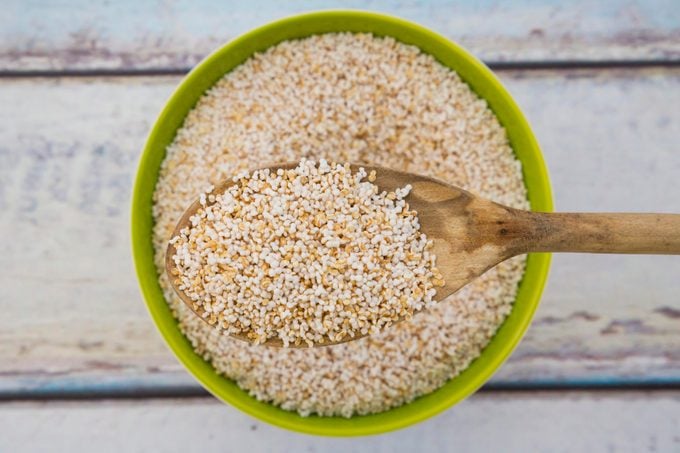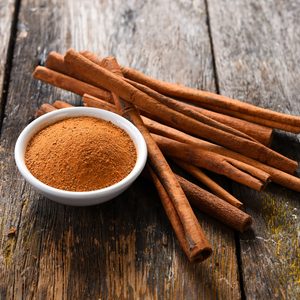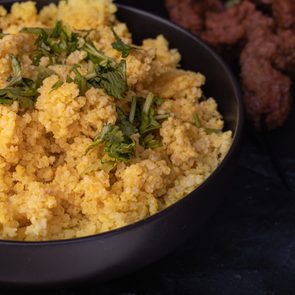Amaranth: This Grain’s Nutrition, Benefits—Plus Recipes
Updated: May 18, 2021
Amaranth is a gluten-free seed that is full of protein, fiber, and micronutrients. Learn more about the seed's health benefits—plus, how to eat it.
What is amaranth?
Amaranth is classified as a pseudocereal—and if that makes you suspicious, it’s okay—it is a real food. But technically, it’s neither a cereal nor a grain but a seed, similar to quinoa. Amaranth is a tiny seed that has an earthy, nutty flavor when cooked and can be prepared similar to rice, but with a higher water-to-grain—or water-to-seed—ratio. Tired of oatmeal? Change things up by preparing amaranth as a breakfast porridge or toast it in a dry skillet for a fun snack. (Scroll down to get the recipe).
Amaranth packs more protein than grains, with nine grams per serving of one cup of cooked amaranth. By comparison, one cup of rice has four grams of protein in one cup, cooked. So it’s especially beneficial and nutritious for people who eat a vegan- or vegetarian-based diet. Loaded with nutrients and minerals, such as calcium, iron, and magnesium, “amaranth is high in protein and fiber, and has double the amount of iron that wheat does,” says Danielle Gaffen, RDN, a registered dietitian nutritionist in San Diego, California.
Read on to learn more about what is amaranth, the nutrition facts, potential health benefits, and how to eat this healthy ancient seed.

Amaranth nutrition facts
It’s easy to see why nutritionists sing the praises of amaranth. It packs a powerful punch with an abundance of vitamins, minerals, and micronutrients.
“Amaranth is filled with nutrients that have tons of beneficial effects all over the body,” says Bansari Acharya, RDN, a registered dietitian nutritionist in Detroit. “It is rich in fiber, protein, minerals, and antioxidants.”
“It is especially high in manganese, which is a vitamin connected to brain function and protects you from many neurological conditions,” adds Jana Mowrer, RDN, a registered dietitian nutritionist in Fresno, California.
This tiny seed “also contains a large amount of vitamin K, which is great for heart health,” says Cassidy Gundersen, nutritionist and health and wellness coach in Provo, Utah.
Here are the nutritional benefits of a one-cup serving (246 grams) of cooked amaranth:
Calories: 251
Protein: 9.4 g (19 percent DV)
Fat: 3.9 g (6 percent DV)
Carbohydrates: 46 g (15 percent DV)
Iron: 5.2 mg (29 percent DV)
Fiber: 5.7 g (21 percent DV)
Calcium: 116 mg (12 percent DV)
Magnesium: 160 mg (40 percent DV)
Manganese: 2.1 mg (105 percent DV)
Phosphorus: 364 mg (36 percent DV)
Gluten-free option for those with celiac disease
Amaranth is naturally gluten-free. So it’s a great choice for people with celiac disease or anyone wanting to reduce their consumption of gluten—a protein found in wheat, rye, and barley. People with celiac disease can’t eat gluten because it will damage their small intestine, leading to abdominal discomfort, diarrhea, and bloating. Those with gluten intolerance will have an undesirable reaction to gluten, similar to celiac disease, with symptoms tied to bowel movements.
“It is a gluten-free option and can fit into many people’s diets, including those with gluten intolerance or celiac disease,” says Gaffen. It can also be used in baked goods such as cookies, muffins, and bread. “Amaranth can be made into a gluten-free flour that adds both a nutty flavor and moistness to baked goods.”
Packed with protein
Amaranth has the highest amount of protein per serving from a plant. That’s a huge plus for vegetarians, vegans, and anyone following a plant-based diet. “Amaranth is rich in protein, complex carbohydrates, antioxidants, manganese, magnesium, iron, selenium, and copper,” says Michelle Routhenstein, RD, a preventive cardiology registered dietitian in New York City.
(Here’s how to eat more protein.)
Origins of the amaranth plant
Like quinoa, amaranth seed comes from the family Amaranthaceae; specifically, the plant Amaranthus L. There are over 75 varieties of this edible plant and, depending on the type, you can eat the nutritious green or red leaves. The tiny seeds have a cream hue.
Amaranth is a staple food in Central and South America, such as Peru and Argentina, and was cultivated by the Aztecs and Mayans. The leaves of the plant are eaten in many regions, including Africa, India, the Caribbean, and China.
Potential health benefits of amaranth
Because amaranth is loaded with many minerals, vitamins, and micronutrients, there are many potential health benefits. Research suggests “amaranth may have some promising health benefits,” Routhenstein says. Those include “lowering cholesterol, boosting immunity, optimizing blood pressure values, and having anti-anemic effects because of its rich nutrient profile.”
Rich in antioxidants
Naturally occurring molecules, antioxidants help the body protect itself from harmful free radicals. There are different types of antioxidants and many are found in plant-based foods, such as amaranth. “Antioxidants that are found in many fruits, vegetables, and grains help get rid of free radicals in the body,” explains Gundersen. “The more antioxidants we can get in our diet, the better.”
Amaranth has phenolic compounds, which can be helpful for heart health. “It is also a rich source of phenolic compounds, such as gallic acid and soluble fiber, which are cardioprotective,” says Routhenstein.
Tames inflammation
Amaranth has plant compounds that can be helpful for minimizing inflammation. “Amaranth contains a potent phytochemical composition that has been shown to reduce inflammation and fight against oxidative stress—two main promoters of heart disease,” says Routhenstein. Reducing oxidative stress is important. “Due to its anti-inflammatory properties, amaranth may reduce the risk of many chronic diseases, such as heart disease,” Acharya adds.
Lowers cholesterol levels
Research suggests amaranth may also lower cholesterol. “Many of the studies that show amaranth may lower cholesterol are done in animal models,” says Acharya. “However, given its favorable soluble fiber content, it may contribute to a reduction in cholesterol in humans.”
Its high level of fiber is beneficial for lowering cholesterol levels. “Fiber has been shown to play a huge role not only in keeping the digestive system healthy, but also in reducing cholesterol levels,” she adds.
Aids weight loss
A high protein, high fiber diet can help reduce appetite and aid in weight loss. In a study published in 2019 in The Journal of Nutrition, an increase in fiber intake was shown to promote weight loss. Amaranth is high in fiber with almost six grams per serving.
“Due to its high fiber content, consume it in moderation as too much fiber in the diet can lead to GI [gastrointestinal] discomfort,” says Mowrer. The beneficial side effects, however, “could be weight loss and increased gut health.”
(These are the best foods and recipes for gut health.)
Risks or side effects
Unless you are allergic to amaranth, there aren’t any side effects. But it’s important to know that this pseudocereal contains antinutrients. Those are molecules that limit or block the absorption of nutrients.
The way you prepare amaranth can help reduce the amount of antinutrients. “Interestingly, sprouting can break down some of the antinutrients in amaranth,” says Gaffen explains. “To sprout the amaranth before cooking, soak it in water for one to three days.”
However, this process isn’t as straightforward because reducing the antinutrients may also lower some of the benefits. “One thing to note is that while amaranth contains many good-for-you antioxidants, soaking and processing amaranth, unfortunately, may decrease the amount of antioxidant properties in the amaranth,” says Gaffen.
How to eat amaranth
Amaranth is a versatile cereal that can be used as a substitute for oatmeal, cooked like rice or quinoa, topped on salads, or added to baked goods.
“Amaranth is great to add into soups or stews to boost the nutrient content and add a hearty element,” says Routhenstein. If you want to change up your morning routine, “it can also replace a cereal or oatmeal in the morning because it soaks up the water and forms into a hearty breakfast meal—delicious paired with berries, walnuts, and a hint of vanilla.”
Cooking amaranth is similar to rice or quinoa, but with increased water or liquid. Typically, it’s three cups of water to one cup amaranth and cooks within 20 to 25 minutes, making it an easy and quick side dish to prepare. You can also eat it as a snack by toasting dry amaranth in a frying pan, says Gaffen.
There are myriad ways to prepare amaranth. But Routhenstein says, “to reap the benefits of amaranth, it needs to be cooked.” You can also bake with amaranth flour. “However, note that amaranth is usually combined with other types of flours in baked goods,” says Gaffen. This is because amaranth is rather dense when used alone and can create cookies or bread that is too dense or heavy. It’s best to mix other gluten-free flours for a lighter creation.
Easy Amaranth Breakfast Porridge
One of Gaffen’s favorite recipes is this amaranth breakfast porridge.
2 servings
Add one cup amaranth and three cups water into a large saucepan. Bring to a boil. Reduce the heat to low, cover, and allow the amaranth mixture to simmer for 20 to 25 minutes, or until the water has been absorbed. Allow to cool for five to 10 minutes before serving. After cooking the amaranth, the options are endless.
Optional mix-ins:
- 1 cup blueberries (boost in antioxidants)
- 1 ounce walnuts (good source of omega-3s)
- 1/2 tsp vanilla
- Sprinkle of cinnamon (boost in antioxidants and other potential health properties)
- 1 Tbsp honey
Gunderman suggests 1 teaspoon cinnamon, 1 teaspoon vanilla, and 2 chopped dates. “Stir well and enjoy!” she says.
Acharya suggests a mix of maple syrup, honey, or brown sugar, and your favorite fruit.
Learn more about how to cook whole grains.






























